Temporal and Spatial Features of the Correlation between PM2.5 and O3 Concentrations in China
Abstract
1. Introduction
2. Materials and Methods
2.1. Research Area and Data
2.2. Methods
3. Results
3.1. Temporal Variation of Particulate Matter of 2.5 µm or Less (PM2.5) and Ozone (O3) Concentrations
3.2. Spatial and Temporal Differences of R-PO
3.2.1. R-PO of Daily Average Concentrations
3.2.2. R-PO of Hourly Concentrations
3.3. Cause Discussion of the Spatial and Temporal Differences of R-PO
3.3.1. The Effects of the Physical Properties of PM2.5 and O3 and the Chemical Mechanisms Associated with Them on R-PO
3.3.2. The Effect of Climatic and Meteorological Conditions on R-PO
4. Conclusions
Author Contributions
Funding
Acknowledgments
Conflicts of Interest
References
- Ministry of Ecology and Environment of People’s Republic of China: 2016 China Environmental Status Bulletin. Available online: http://www.mee.gov.cn/hjzl/ (accessed on 31 May 2017).
- Engel-Cox, J.; Kim Oanh, N.T.; van Donkelaar, A.; Martin, R.V.; Zell, E. Toward the next generation of air quality monitoring: Particulate Matter. Atmos. Environ. 2013, 80, 584–590. [Google Scholar] [CrossRef]
- Kim, K.H.; Kabir, E.; Kabir, S. A review on the human health impact of airborne particulate matter. Environ. Int. 2015, 74, 136–143. [Google Scholar] [CrossRef] [PubMed]
- Li, G.X.; Xue, M.; Zeng, Q.; Cai, Y.; Pan, X.C.; Meng, Q. Association between fine ambient particulate matter and daily total mortality: An analysis from 160 communities of China. Sci. Total Environ. 2017, 599, 108–113. [Google Scholar] [CrossRef] [PubMed]
- Niu, H.Y.; Hu, W.; Zhang, D.Z.; Wu, Z.J.; Guo, S.; Pian, W.; Cheng, W.J.; Hu, M. Variations of fine particle physiochemical properties during a heavy haze episode in the winter of Beijing. Sci. Total Environ. 2016, 571, 103–109. [Google Scholar] [CrossRef]
- Huang, K.; Zhuang, G.; Lin, Y.; Fu, J.S.; Wang, Q.; Liu, T.; Zhang, R.; Jiang, Y.; Deng, C.; Fu, Q.; et al. Typical types and formation mechanisms of haze in an Eastern Asia megacity, Shanghai. Atmos. Chem. Phys. 2012, 12, 105–124. [Google Scholar] [CrossRef]
- Li, L.L.; Tan, Q.W.; Zhang, Y.H.; Feng, M.; Qu, Y.; An, J.L.; Liu, X.G. Characteristics and source apportionment of PM2.5 during persistent extreme haze events in Chengdu, southwest China. Environ. Pollut. 2017, 230, 718–729. [Google Scholar] [CrossRef]
- Huang, Y.Y.; Yan, Q.W.; Zhang, C.R. Spatial–Temporal Distribution Characteristics of PM2.5 in China in 2016. J. Geovis. Spat. Anal. 2018, 2, 12. [Google Scholar] [CrossRef]
- Sillman, S. The use of NOy, H2O2, and HNO3 as indicators for ozone-NOx-hydrocarbon sensitivity in urban locations. J. Geophys. Res. Atmos. 1995, 100, 14175–14188. [Google Scholar] [CrossRef]
- Peng, X.L.; Shen, H.F.; Zhang, L.P.; Zeng, C.; Yang, G.; He, Z.Y. Spatially continuous mapping of daily global ozone distribution (2004–2014) with the Aura OMI sensor. J. Geophys. Res. Atmos. 2016, 121, 12702–12722. [Google Scholar] [CrossRef]
- Yang, C.X.; Yang, H.B.; Guo, S.; Wang, Z.S.; Xu, X.H.; Duan, X.L.; Kan, H.D. Alternative ozone metrics and daily mortality in Suzhou: The China Air Pollution and Health Effects Study (CAPES). Sci. Total Environ. 2012, 426, 83–89. [Google Scholar] [CrossRef]
- Ito, K.; De Leon, S.F.; Lippmann, M. Associations between Ozone and Daily Mortality: Analysis and Meta-Analysis. Epidemiology 2005, 16, 446–457. [Google Scholar] [CrossRef] [PubMed]
- Zhang, Y.; Huang, W.; London, S.J.; Song, G.; Chen, G.; Jiang, L.; Zhao, N.; Chen, B.; Kan, H. Ozone and daily mortality in Shanghai, China. Environ. Health Perspect. 2006, 114, 1227–1232. [Google Scholar] [CrossRef] [PubMed]
- Aris, R.M.; Christian, D.; Hearne, P.Q.; Kerr, K.; Finkbeiner, W.E.; Balmes, J.R. Ozone-induced Airway Inflammation in Human Subjects as Determined by Airway Lavage and Biopsy. Am. Rev. Respir. Dis. 1993, 148, 1363–1372. [Google Scholar] [CrossRef] [PubMed]
- Alharbi, B.H.; Alduwais, A.K.; Alhudhodi, A.H. An analysis of the spatial distribution of O3 and its precursors during summer in the urban atmosphere of Riyadh, Saudi Arabia. Atmos. Pollut. Res. 2017, 8, 861–872. [Google Scholar] [CrossRef]
- Huang, C.; Chen, C.H.; Li, L.; Cheng, Z.; Wang, H.L.; Huang, H.Y.; Streets, D.G.; Wang, Y.J.; Zhang, G.F.; Chen, Y.R. Emission inventory of anthropogenic air pollutants and VOC species in the Yangtze River Delta region, China. Atmos. Chem. Phys. 2011, 11, 4105–4120. [Google Scholar] [CrossRef]
- Shen, F.Z.; Ge, X.L.; Hu, J.L.; Nie, D.Y.; Tian, L.; Chen, M.D. Air pollution characteristics and health risks in Henan Province, China. Environ. Res. 2017, 156, 625–634. [Google Scholar] [CrossRef]
- Brauer, M.; Freedman, G.; Frostad, J.; van Donkelaar, A.; Martin, R.V.; Dentener, F.; Dingenen, R.V.; Estep, K.; Amini, H.; Apte, J.S.; et al. Ambient Air Pollution Exposure Estimation for the Global Burden of Disease 2013. Environ. Sci. Technol. 2016, 50, 79. [Google Scholar] [CrossRef]
- Zhao, S.P.; Yu, Y.; Yin, D.Y.; He, J.J.; Liu, N.; Qu, J.J.; Xiao, J.H. Annual and diurnal variations of gaseous and particulate pollutants in 31 provincial capital cities based on in situ air quality monitoring data from China National Environmental Monitoring Center. Environ. Int. 2016, 86, 92–106. [Google Scholar] [CrossRef]
- Guo, H.; Cheng, T.H.; Gu, X.F.; Wang, Y.; Chen, H.; Bao, F.W.; Shi, S.Y.; Xu, B.R.; Wang, W.N.; Zuo, X.; et al. Assessment of PM2.5 concentrations and exposure throughout China using ground observations. Sci. Total Environ. 2017, 601, 1024–1030. [Google Scholar] [CrossRef]
- Li, R.; Cui, L.L.; Li, J.L.; Zhao, A.; Fu, H.B.; Wu, Y.; Zhang, L.W.; Kong, L.D.; Chen, J.M. Spatial and temporal variation of particulate matter and gaseous pollutants in China during 2014–2016. Atmos. Environ. 2017, 161, 235–246. [Google Scholar] [CrossRef]
- Li, T.W.; Shen, H.F.; Yuan, Q.Q.; Zhang, X.C.; Zhang, L.P. Estimating Ground-Level PM2.5 by Fusing Satellite and Station Observations: A Geo-Intelligent Deep Learning Approach. Geophys. Res. Lett. 2017, 44, 11985–11993. [Google Scholar] [CrossRef]
- Li, T.W.; Shen, H.F.; Zeng, C.; Yuan, Q.Q.; Zhang, L.P. Point-surface fusion of station measurements and satellite observations for mapping PM2.5 distribution in China: Methods and assessment. Atmos. Environ. 2017, 152, 477–489. [Google Scholar] [CrossRef]
- Song, C.B.; Wu, L.; Xie, Y.C.; He, J.J.; Chen, X.; Wang, T.; Lin, Y.C.; Jin, T.S.; Wang, A.X.; Liu, Y.; et al. Air pollution in China: Status and spatiotemporal variations. Environ. Pollut. 2017, 227, 334–347. [Google Scholar] [CrossRef] [PubMed]
- Zhang, Z.Y.; Zhang, X.L.; Gong, D.Y.; Quan, W.J.; Zhao, X.J.; Ma, Z.Q.; Kim, S.-J. Evolution of surface O3 and PM2.5 concentrations and their relationships with meteorological conditions over the last decade in Beijing. Atmos. Environ. 2015, 108, 67–75. [Google Scholar] [CrossRef]
- Harden, L. Diurnal and seasonal characteristics of ozone and PM2.5 in Great Smoky Mountain National Park, Look Rock, TN. J. Stud. Res. Environ. Sci. Appalach. 2013, 3, 18–25. [Google Scholar]
- Wang, Z.S.; Zhang, D.W.; Li, Y.T.; Dong, X.; Sun, R.W.; Sun, N.D. Different Air Pollution Situations of O3 and PM2. 5 During Summer in Beijing. Environ. Sci. 2016, 37, 807–815. [Google Scholar]
- Luo, L.P.; Liu, M.J.; Gan, J.; Zhou, X.T.; Jiang, M.; Yang, R.B. Correlation study on PM2.5 and O3 mass concentrations in ambient air by taking urban cluster of Changsha, Zhuzhou and Xiangtan as an example. J. Saf. Environ. 2015, 15, 313–317. [Google Scholar]
- Chen, K.; Zhou, L.; Chen, X.; Bi, J.; Kinney, P.L. Acute effect of ozone exposure on daily mortality in seven cities of Jiangsu Province, China: No clear evidence for threshold. Environ. Res. 2017, 155, 235–241. [Google Scholar] [CrossRef]
- Wang, Y.G.; Ying, Q.; Hu, J.L.; Zhang, H.L. Spatial and temporal variations of six criteria air pollutants in 31 provincial capital cities in China during 2013–2014. Environ. Int. 2014, 73, 413–422. [Google Scholar] [CrossRef]
- Li, K.; Jacob, D.J.; Liao, H.; Shen, L.; Zhang, Q.; Bates, K.H. Anthropogenic drivers of 2013–2017 trends in summer surface ozone in China. Proc. Natl. Acad. Sci. USA 2019, 116, 422–427. [Google Scholar] [CrossRef]
- Tai, A.P.K.; Mickley, L.J.; Jacob, D.J. Correlations between fine particulate matter (PM2.5) and meteorological variables in the United States: Implications for the sensitivity of PM2.5 to climate change. Atmos. Environ. 2010, 44, 3976–3984. [Google Scholar] [CrossRef]
- Li, J.L.; Wu, L.X.; Ren, C.B.; Chai, M.; Zhang, Y.Y.; Xiang, C.C. Impact of APEC Regional Emission Reduction on Spatio-Temporal Variation of PM_(2.5) Concentration in Beijing. Geogr. Geo-Inf. Sci. 2016, 32, 110–115. [Google Scholar]
- Shen, H.; Li, T.; Yuan, Q.; Zhang, L. Estimating Regional Ground-Level PM2. 5 Directly From Satellite Top-Of-Atmosphere Reflectance Using Deep Belief Networks. J. Geophys. Res. Atmos. 2018, 123, 13875–813886. [Google Scholar] [CrossRef]
- Lan, Z.J.; Zhang, B.; Huang, X.F.; Zhu, Q.; Yuan, J.F.; Zeng, L.W.; Hu, M.; He, L.Y. Source apportionment of PM2.5 light extinction in an urban atmosphere in China. J. Environ. Sci. China 2017, 63, 277–284. [Google Scholar] [CrossRef]
- Li, C.L.; Chen, P.F.; Kang, S.C.; Yan, F.P.; Hu, Z.F.; Qu, B.; Sillanpää, M. Concentrations and light absorption characteristics of carbonaceous aerosol in PM2.5 and PM10 of Lhasa city, the Tibetan Plateau. Atmos. Environ. 2016, 127, 340–346. [Google Scholar] [CrossRef]
- Wang, J.L.; Zhang, Y.H.; Shao, M.; Liu, X.L.; Zeng, L.M.; Cheng, C.L.; Xu, X.F. Quantitative relationship between visibility and mass concentration of PM2.5 in Beijing. J. Environ. Sci. China 2006, 18, 475–481. [Google Scholar]
- Atkinson, R. Atmospheric chemistry of VOCs and NOx. Atmos. Environ. 2000, 34, 2063–2101. [Google Scholar] [CrossRef]
- Chan, C.Y.; Chan, L.Y. Effect of meteorology and air pollutant transport on ozone episodes at a subtropical coastal Asian city, Hong Kong. J. Geophys. Res. Atmos. 2000, 105, 20707–20724. [Google Scholar] [CrossRef]
- Qin, W.M.; Liu, Y.; Wang, L.C.; Lin, A.W.; Xia, X.G.; Che, H.Z.; Bilal, M.; Zhang, M. Characteristic and Driving Factors of Aerosol Optical Depth over Mainland China during 1980–2017. Remote Sens. 2018, 10, 1064. [Google Scholar] [CrossRef]
- Takekawa, H.; Minoura, H.; Yamazaki, S. Temperature dependence of secondary organic aerosol formation by photo-oxidation of hydrocarbons. Atmos. Environ. 2003, 37, 3413–3424. [Google Scholar] [CrossRef]
- Wonaschütz, A.; Demattio, A.; Wagner, R.; Burkart, J.; Zíková, N.; Vodička, P.; Ludwig, W.; Steiner, G.; Schwarz, J.; Hitzenberger, R. Seasonality of new particle formation in Vienna, Austria–Influence of air mass origin and aerosol chemical composition. Atmos. Environ. 2015, 118, 118–126. [Google Scholar] [CrossRef]
- Zhang, Y.L.; Cao, F. Fine particulate matter (PM 2.5) in China at a city level. Sci. Rep. UK 2015, 5, 14884. [Google Scholar] [CrossRef] [PubMed]
- Griffin, R.J.; Dabdub, D.; Kleeman, M.J.; Fraser, M.P.; Cass, G.R.; Seinfeld, J.H. Secondary organic aerosol 3. Urban/regional scale model of size- and composition-resolved aerosols. J. Geophys. Res. Atmos. 2002, 107, AAC 5-1–AAC 5-14. [Google Scholar] [CrossRef]
- Shao, P.; Xin, J.Y.; An, J.L.; Wang, J.X.; Wu, F.K.; Wang, Y.S. An Analysis on the Relationship between Ground-Level Ozone and Particulate Matter in an Industrial Area in the Yangtze River Delta during Summer Time. Chin. J. Atmos. Sci. 2017, 41, 618–628. [Google Scholar]
- Guo, S.; Hu, M.; Wang, Z.B.; Slanina, J.; Zhao, Y.L. Size-resolved aerosol water-soluble ionic compositions in the summer of Beijing: Implication of regional secondary formation. Atmos. Chem. Phys. 2010, 10, 947–959. [Google Scholar] [CrossRef]
- Lyu, X.P.; Guo, H.; Cheng, H.R.; Wang, D.W. New particle formation and growth at a suburban site and a background site in Hong Kong. Chemosphere 2018, 193, 664–674. [Google Scholar] [CrossRef]
- Ji, D.S.; Wang, Y.S.; Wang, L.L.; Chen, L.F.; Hu, B.; Tang, G.Q.; Xin, J.Y.; Song, T.; Wen, T.X.; Sun, Y.; et al. Analysis of heavy pollution episodes in selected cities of northern China. Atmos. Environ. 2012, 50, 338–348. [Google Scholar] [CrossRef]
- Clarke, A.D.; Davis, D.; Kapustin, V.N.; Eisele, F.; Chen, G.; Paluch, I.; Lenschow, D.; Bandy, A.R.; Thornton, D.; Moore, K.; et al. Particle Nucleation in the Tropical Boundary Layer and Its Coupling to Marine Sulfur Sources. Science 1998, 282, 89. [Google Scholar] [CrossRef]
- Perry, K.D.; Hobbs, P.V. Further evidence for particle nucleation in clear air adjacent to marine cumulus clouds. J. Geophys. Res. Atmos. 1994, 99, 22803–22818. [Google Scholar] [CrossRef]
- Lv, B.L.; Cai, J.; Xu, B.; Bai, Y.Q. Understanding the Rising Phase of the PM (2.5) Concentration Evolution in Large China Cities. Sci. Rep. UK 2017, 7, 46456. [Google Scholar] [CrossRef]
- Tania, F.; Peilin, L.; Nelson, B.; Pengjun, Z. Trends of PM2.5 concentrations in China: A long term approach. J. Environ. Manag. 2017, 196, 719–732. [Google Scholar]
- Chen, T.; He, J.; Lu, X.; She, J.; Guan, Z. Spatial and Temporal Variations of PM2.5 and Its Relation to Meteorological Factors in the Urban Area of Nanjing, China. Int. J. Environ. Res. Pub. Health 2016, 13, 921. [Google Scholar] [CrossRef] [PubMed]
- Yang, Q.Q.; Yuan, Q.Q.; Li, T.W.; Shen, H.F.; Zhang, L.P. The Relationships between PM2.5 and Meteorological Factors in China: Seasonal and Regional Variations. Int. J. Environ. Res. Pub. Health 2017, 14, 1510. [Google Scholar] [CrossRef] [PubMed]

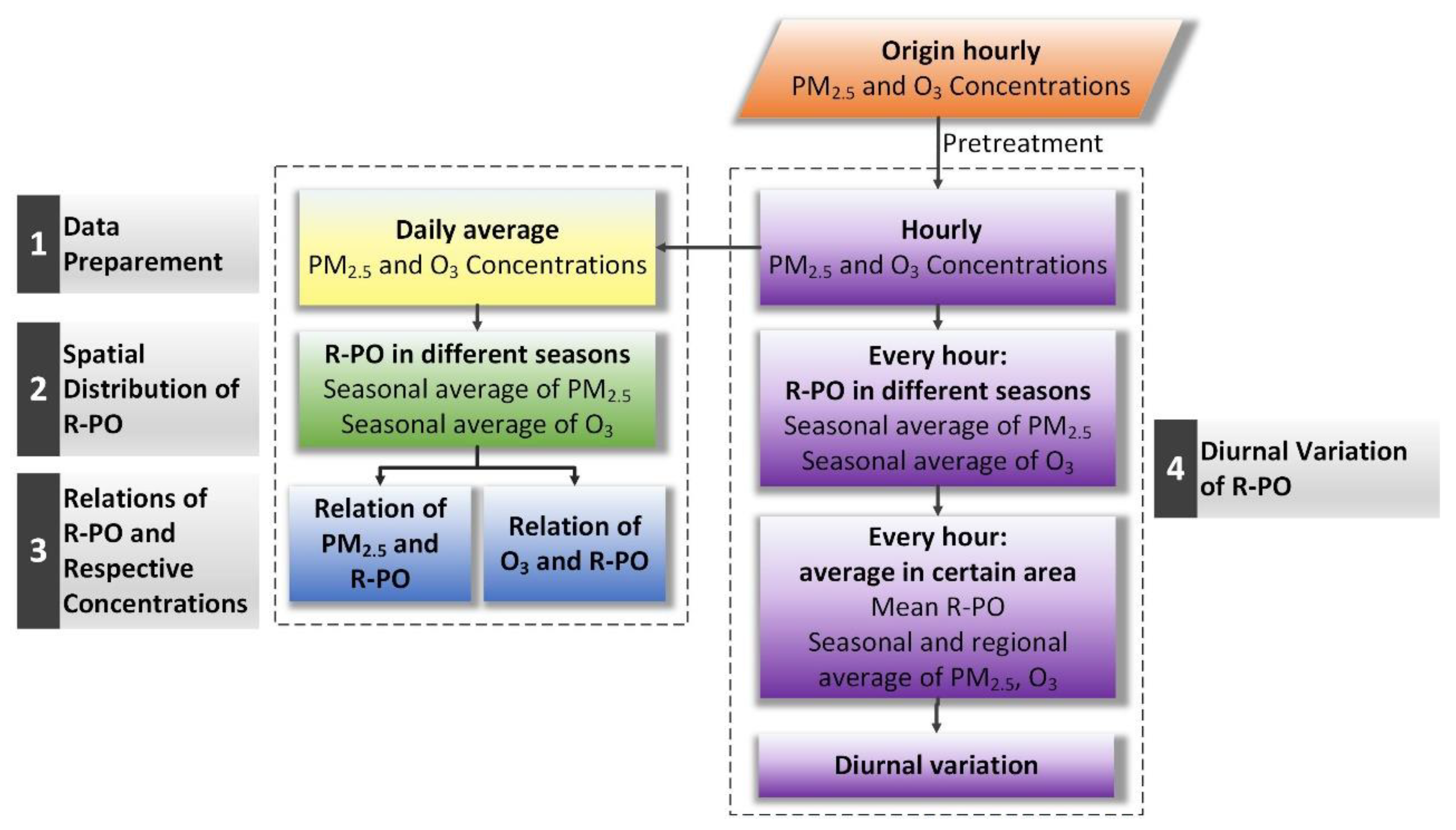
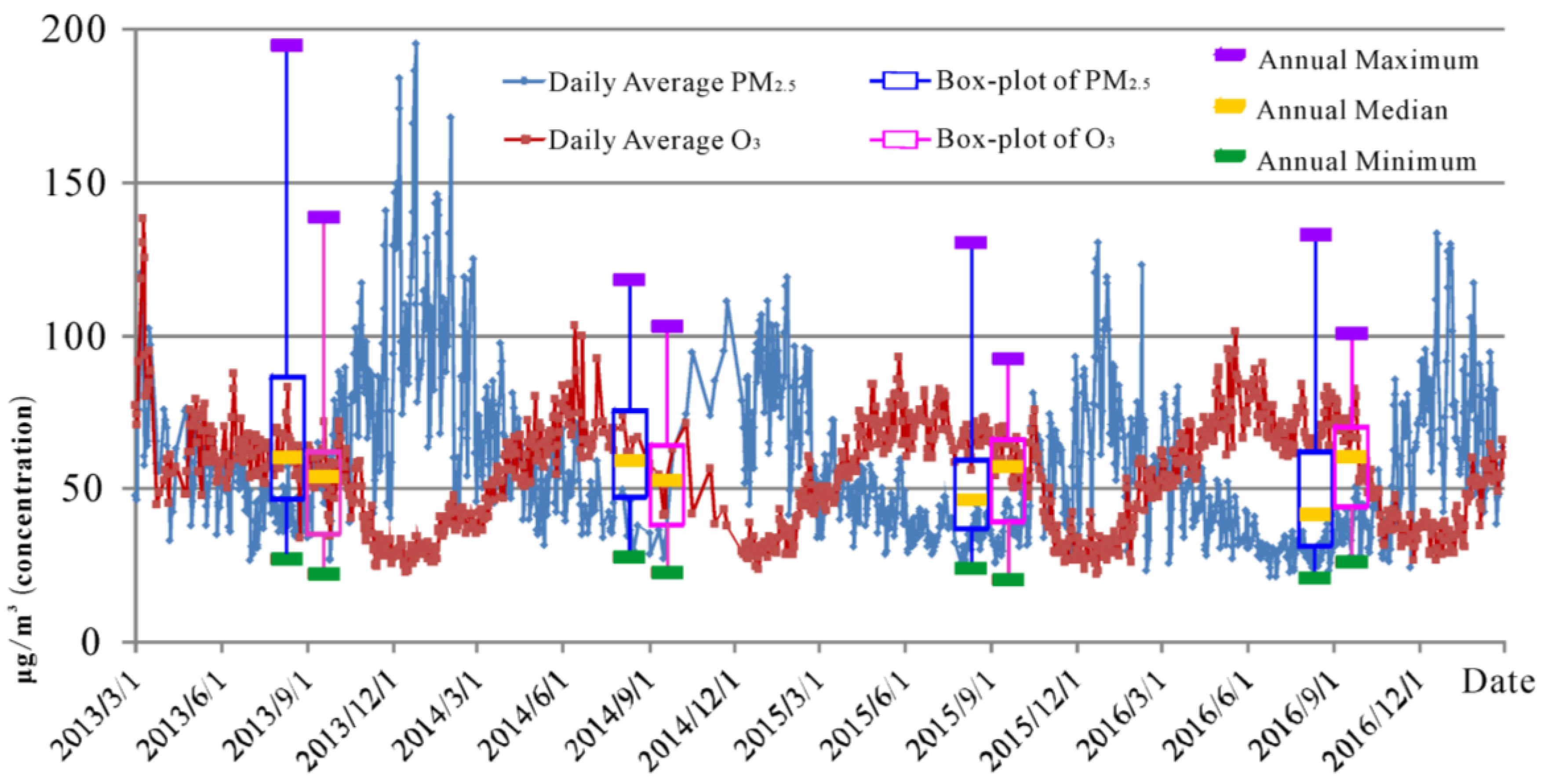
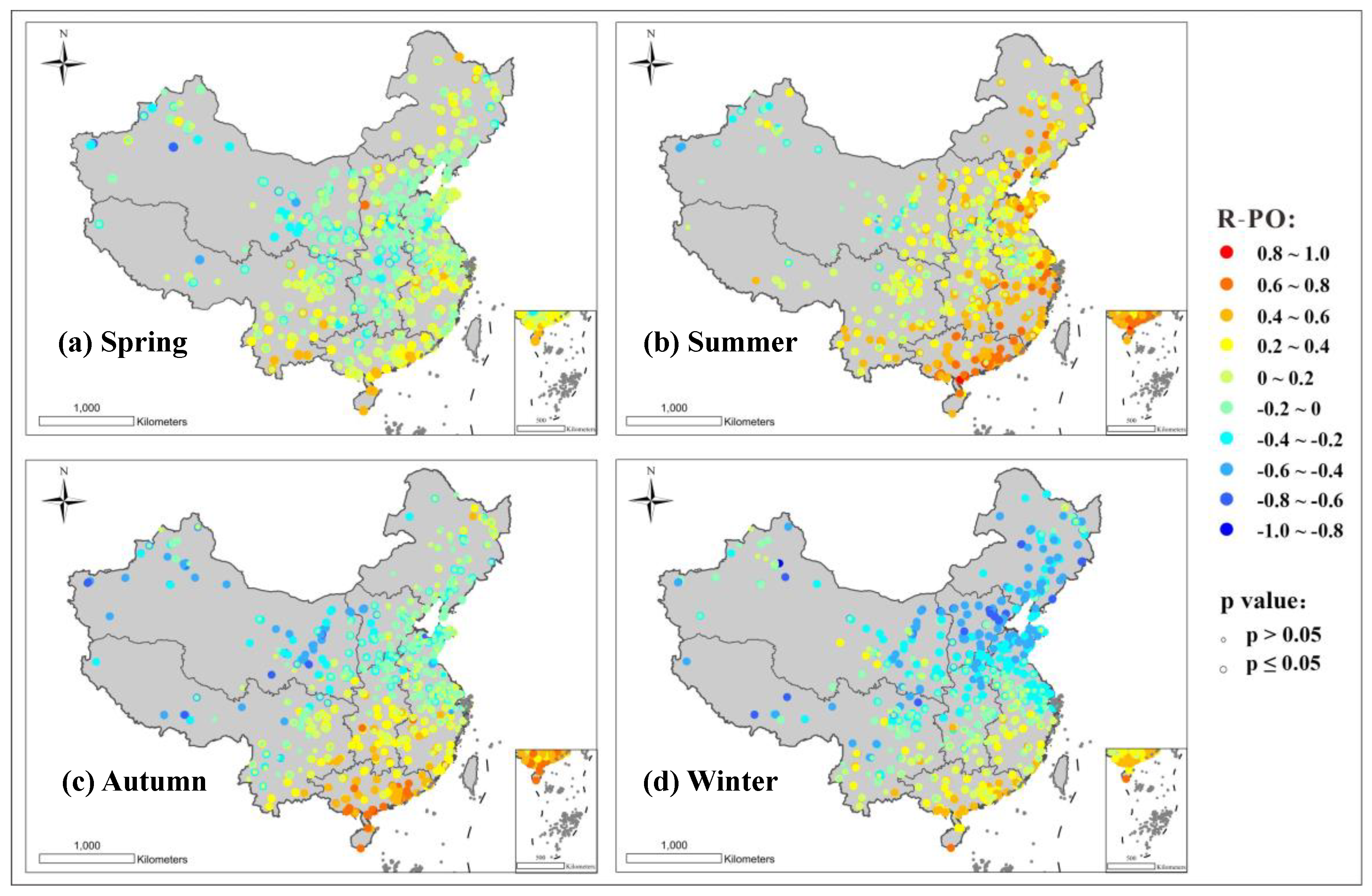


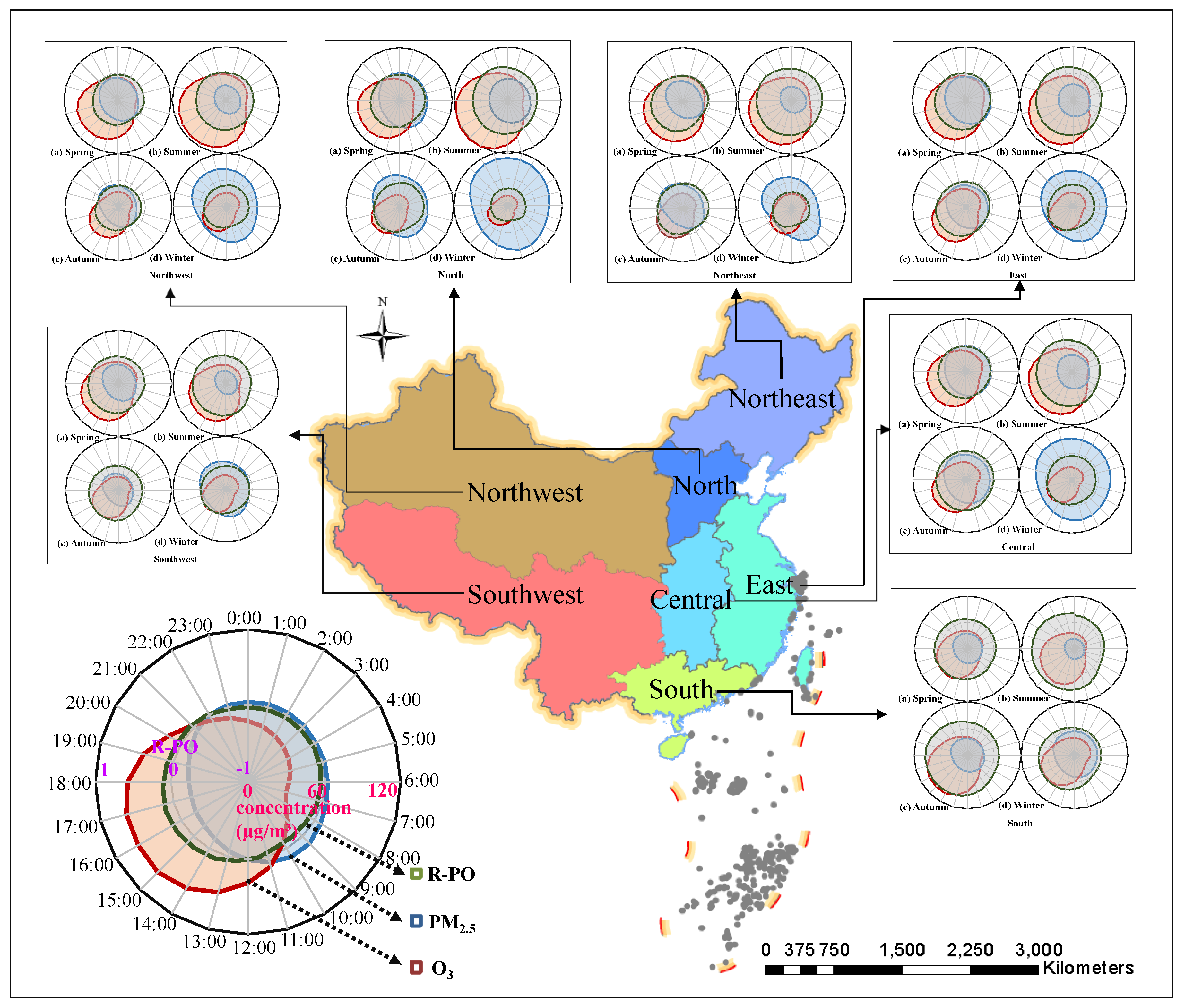
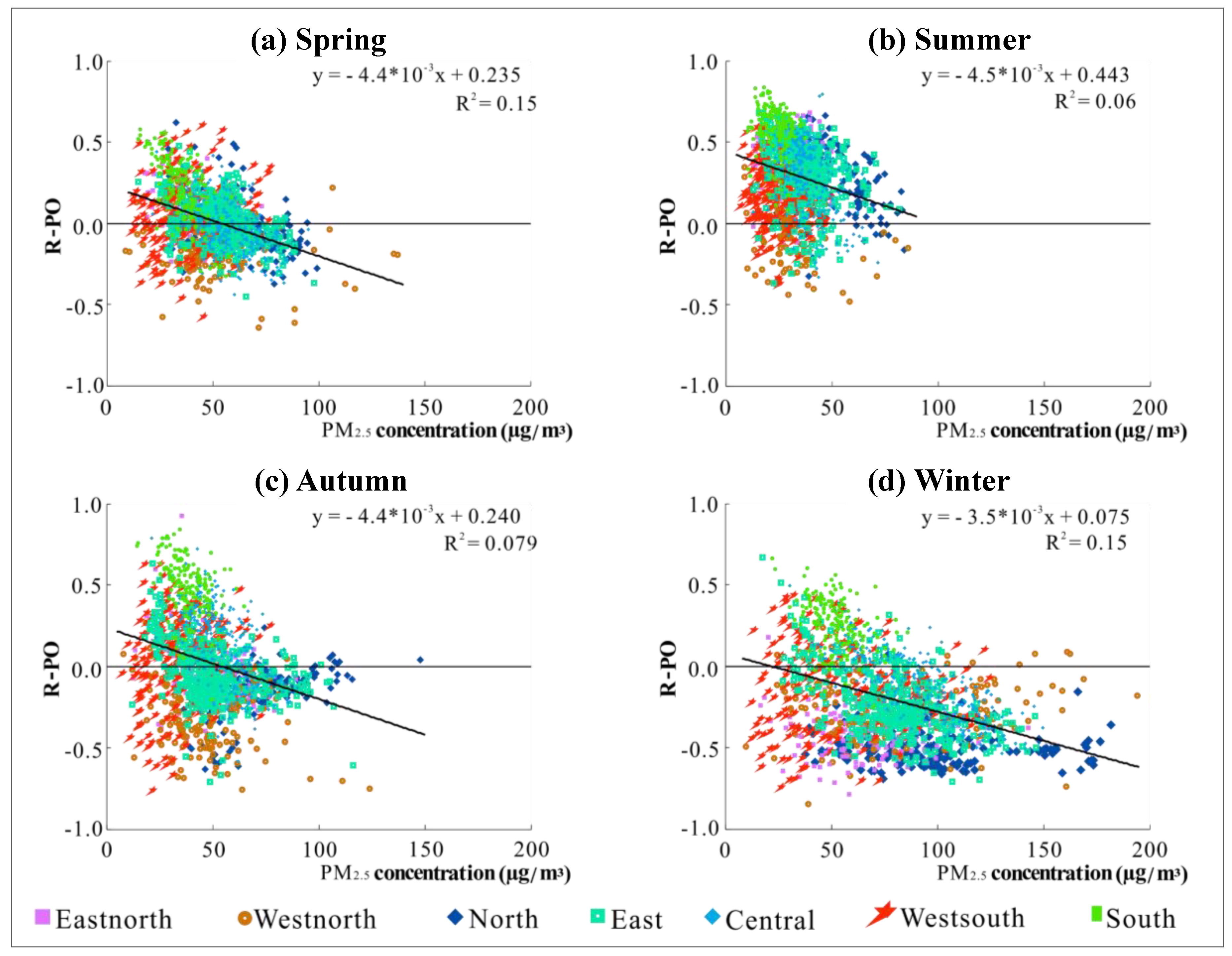
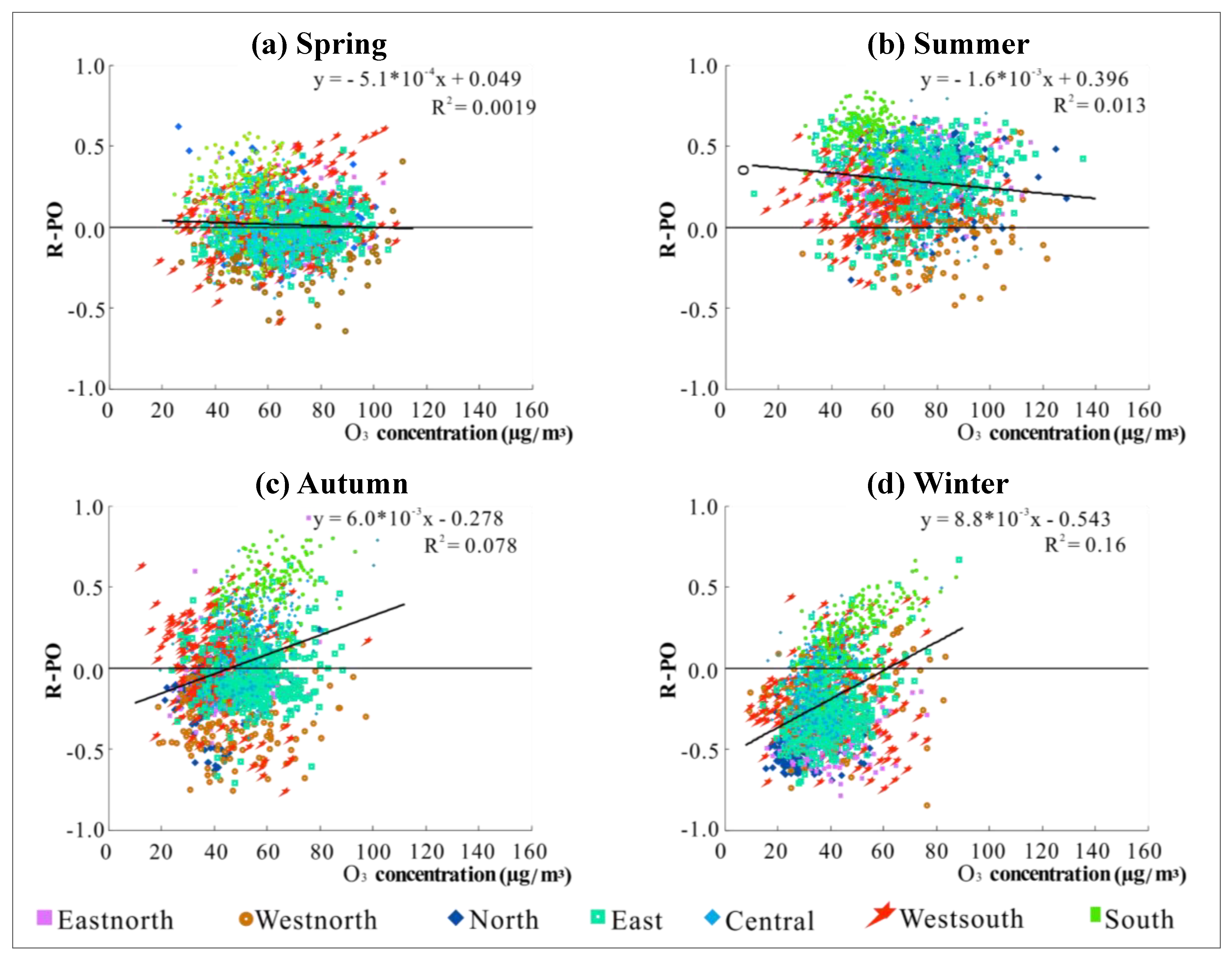
| Time Zone | Longitude Range | Correction | Number of Stations |
|---|---|---|---|
| UTC + 5 | 67.5–82.5 °E | [UTC + 8] − 3 h | 13 |
| UTC + 6 | 82.5–97.5 °E | [UTC + 8] − 2 h | 46 |
| UTC + 7 | 97.5–112.5 °E | [UTC + 8] − 1 h | 506 |
| UTC + 8 | 112.5–127.5 °E | - | 947 |
| UTC + 9 | 127.5–132.5 °E | [UTC + 8] + 1 h | 32 |
© 2019 by the authors. Licensee MDPI, Basel, Switzerland. This article is an open access article distributed under the terms and conditions of the Creative Commons Attribution (CC BY) license (http://creativecommons.org/licenses/by/4.0/).
Share and Cite
Chen, J.; Shen, H.; Li, T.; Peng, X.; Cheng, H.; Ma, C. Temporal and Spatial Features of the Correlation between PM2.5 and O3 Concentrations in China. Int. J. Environ. Res. Public Health 2019, 16, 4824. https://doi.org/10.3390/ijerph16234824
Chen J, Shen H, Li T, Peng X, Cheng H, Ma C. Temporal and Spatial Features of the Correlation between PM2.5 and O3 Concentrations in China. International Journal of Environmental Research and Public Health. 2019; 16(23):4824. https://doi.org/10.3390/ijerph16234824
Chicago/Turabian StyleChen, Jiajia, Huanfeng Shen, Tongwen Li, Xiaolin Peng, Hairong Cheng, and Chenyan Ma. 2019. "Temporal and Spatial Features of the Correlation between PM2.5 and O3 Concentrations in China" International Journal of Environmental Research and Public Health 16, no. 23: 4824. https://doi.org/10.3390/ijerph16234824
APA StyleChen, J., Shen, H., Li, T., Peng, X., Cheng, H., & Ma, C. (2019). Temporal and Spatial Features of the Correlation between PM2.5 and O3 Concentrations in China. International Journal of Environmental Research and Public Health, 16(23), 4824. https://doi.org/10.3390/ijerph16234824







